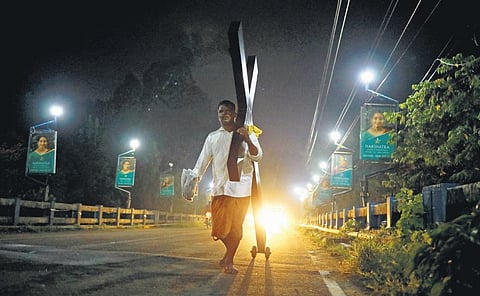

KOCHI: In the rocky hills of Malayattoor, thousands of pilgrims trek their way up the winding paths of Kurishumudi — the hill of the holy cross. These believers come from across Kerala, as well as neighbouring states, to participate in the annual feast of Malayattoor. Malayattoor is the first Christian pilgrim centre in India to be accorded international status by the Holy See, the official seat of the Vatican.
During the Easter lent period, devotees, many wearing kaavi (saffron wear), can be seen walking from faraway towns for the 3km trek. Some of them carry heavy wooden crosses on their shoulders all the way up to the shrine of St Thomas. And the hills reverberate with chants of ‘Ponnin Kurishu Muthappo Ponmalakettam’.
The annual festival, ‘Malayattoor Perunnal’, falls on the first Sunday after Easter. “It is also called ‘Puthu Njayarazhcha’ (New Sunday). The festival is commemorated as it is believed that Jesus appeared in front of St Thomas eight days after his resurrection,” says historian and writer Varghese Angamaly.
As per oral traditions, St. Thomas came to Malayattoor in AD 52. He started preaching and converting people to Christianity. At first, however, his sermons weren’t paid heed by many. Saddened by this, he went up the hill and prayed. Virgin Mary appeared before him and asked him to continue preaching.
“Until the sixth century, however, the pilgrimage was not done in the name of St. Thomas,” says Fr. Ignatius Payyappilly, archivist and curator of the Archdiocese of Ernakulam-Angamaly.
“Legend has it that a few hunters discovered a radiant cross-shaped formation atop a rock on which St. Thomas had knelt and prayed. As they tried to take out the glowing part of the rock, blood oozed from it. Bewildered, they ran and informed the people.”
As people thronged the hilltop, they saw marks of St Thomas’s knee- and footprints were seen beside the radiant ‘golden cross’. “That’s how the place got the name ‘Kurishumudi’ (cross+hill),” says Fr. Ignatius.
Why do the chants refer to ‘Muthappan’? “It could have been derived from Buddhism,” he says. “According to one version of history, the initial community that St Thomas had converted was not Brahmins, but people who believed in Buddhism and Jainism.”
Besides wooden crosses, some devotees carry heavy stones on their heads as offerings. It is also common to see devotees climb the hill on their knees as a form of penance. “It’s a means to redemption, or a plea to fulfil prayers,” says Varghese.
As they climb the hill, pilgrims also chant the ‘Way of the Cross prayer’, stopping at 14 points, symbolic of the ‘Stations of the Cross’. “Interestingly, people used to carry gingelly and salt as offerings. This is because the area was once inhabited by Nilgiri Tahr, and these were their main food,” notes Varghese.